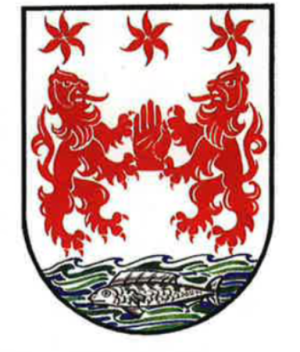There are several different septs of the O’Neills in Counties Clare (where the name is also spelt O’Nihill), Waterford and Carlow. The most famous of the O’Neills, however, are the O’Neills of Tyrone, in the province of Ulster. The name in Gaelic means descendant of Neil or Niall, which was, and still is, a popular personal name in Ireland. In the U.S. the name is sometimes spelt O’Neale and, as with many other names of this form, the “O” is sometimes dropped.
The O’Neills of Tyrone are descended from the famous “Niall of the Nine Hostages,” who was King of Ireland from 379 to 405 A.D. Niall’s name originated from the fact that, during his many raids on surrounding territories, he had captured hostages from all of the five ancient provinces of Ireland, and also from the Scottish, French, British and Saxon tribes. Indeed, St. Patrick is said to have first come to Ireland as a captive taken on one of Niall’s raids on Britain.
The O’Neills were a fiercely independent people and their territories were never taken by the Normans, nor by the English in their early attempts to conquer Ireland. Perhaps the greatest champion of the O’Neills, and one of the great champions of all Ireland, was Hugh O’Neill, who successfully defended his territories against a series of encroaching English forces from 1595 until 1601. Ironically, it was the long-awaited arrival of his Spanish allies to assist him that led to his defeat. The Spaniards landed in the south of Ireland, and, forced to leave his Northern territories to join them, O’Neill was defeated at the Battle of Kinsale.
Hugh O’Neill and the other Ulster ally chieftains, such as the O’Donnells, were the last of the Gaelic chieftains and their eventual departure from Ireland, in the so-called Flight of the Earls, marks the end of the old Gaelic order in Ireland. He died in Rome in 1616 and it is significant that his death is the last entry in the Annals of the Four Masters, a medieval Gaelic history of Ireland.
O’Neills continued to play a prominent part in Irish history, however. Owen Roe O’Neill (15901649), a nephew of Hugh O’Neill who had served with distinction in the Spanish Army, was the leader of the Irish Army during the Catholic Confederacy. Phelim O’Neill also served in the same army and was executed for his activities in 1653.
In the U.S. John O’Neill (1834-1878) carried on the struggle for Irish independence. He was born in County Monaghan, emigrated to the U.S. at age 14 and joined the Union Army in 1857. He served with distinction in the army during the Civil War. Later he joined the Fenian movement and led the ill-fated Fenian raids on Canada in 1866 and after.
Other O’Neills who played a more significant role in U.S. military history were the 180 who served in the American Revolutionary Army. Among them were eight officers, including Captain William O’Neill who served with great distinction at the battle of the Brandywine; Captain Ferdinand O’Neill of Lee’s Battalion S.C. Light Dragoons; and Captain John O’Neill of the French-Irish Brigade.
O’Neills continue to play a prominent role in Irish life, including politics. Sir Terence O’Neill (1914-1990) was Prime Minister in Northern Ireland from 1963 until 1969 and was an advocate of increased North-South cooperation. In the U.S., prominent O’Neill politicians include Edward Asbury O’Neal (1818-1890), a confederate officer who was later governor of Alabama during the period of that state’s reconstruction after the Civil War; and Thomas (Tip) O’Neill, a prominent politician whose career positions included member of congress and Speaker of the House of Representatives from 1976-1986.
Another public servant, Francis O’Neill (1849-1936), was a superintendent in the Chicago Police. His passion was music and one expression of this interest was that when he came across needy Irish musicians he gave them stable police employment and time to develop their music. Francis himself was a major collector of music and folklore and published many important collections including Music of Ireland, 1001 Gems of Irish Melody and Irish Minstrels and Musicians.
Other O’Neills who achieved distinction in the arts include Eugene O’Neill (1888-1953), who was one of America’s great dramatists and the 1936 winner of the Nobel Prize for literature. His major works include Moon for the Misbegotten and Long Day’s Journey Into Night. Eugene’s father, James O’Neill (1849-1920), was born in Kilkenny and emigrated to the U.S. He went on the stage at the age of 18 and must rank as one of the most typecast actors of all time. In 1882, he appeared in the role of Edmund Dantes in The Count of Monte Cristo and was so popular in the role that he played it some 6,000 times.
Irish America’s Top 100 list featured many members of the clan over the years including New York Yankees baseball player Paul O’Neill, whose sister, Molly, is a New York Times columnist; human rights lawyer, William O’Neill, whose grandfather, Congressman Harry P. O’Neill, represented the mining district of Scranton, and whose brother Tom, a writer for US magazine, was nominated for an American Society of Magazine Editors Award; Terry O’Neil of NBC Sports fame: and Peter O’Neill who runs the annual Celtic Music and Arts festival in San Francisco. The family is also well-represented in corporate America and the magazine’s 1996 Business 100 list included Kathleen O’Neil, executive vice president of the Federal Reserve Bank of New York, and Paul O’Neill, Chairman and CEO of Aluminum Co. of America.
Editor’s Note: This article was originally published in the January/February 1997 issue of Irish America. ⬥


Leave a Reply